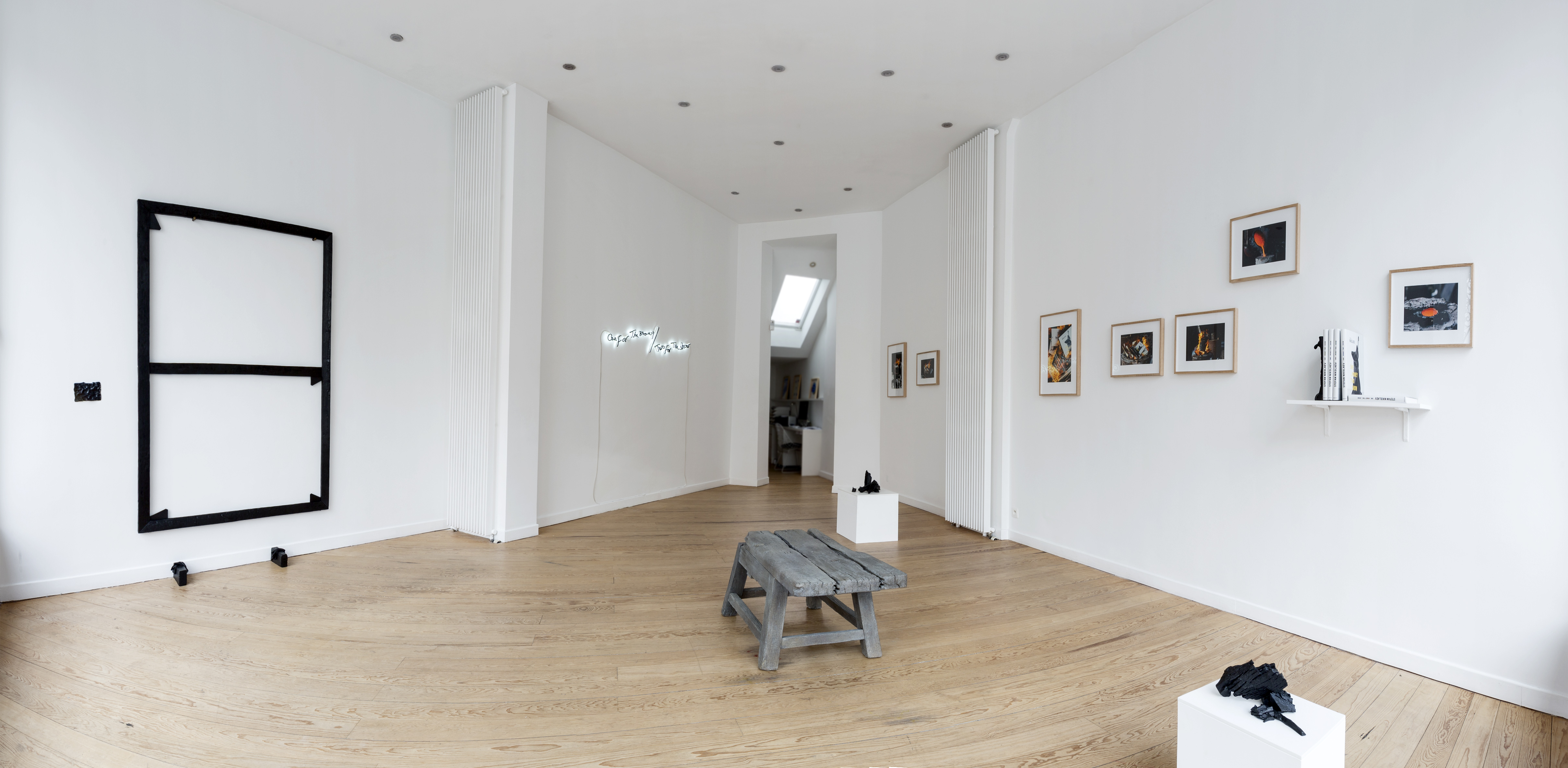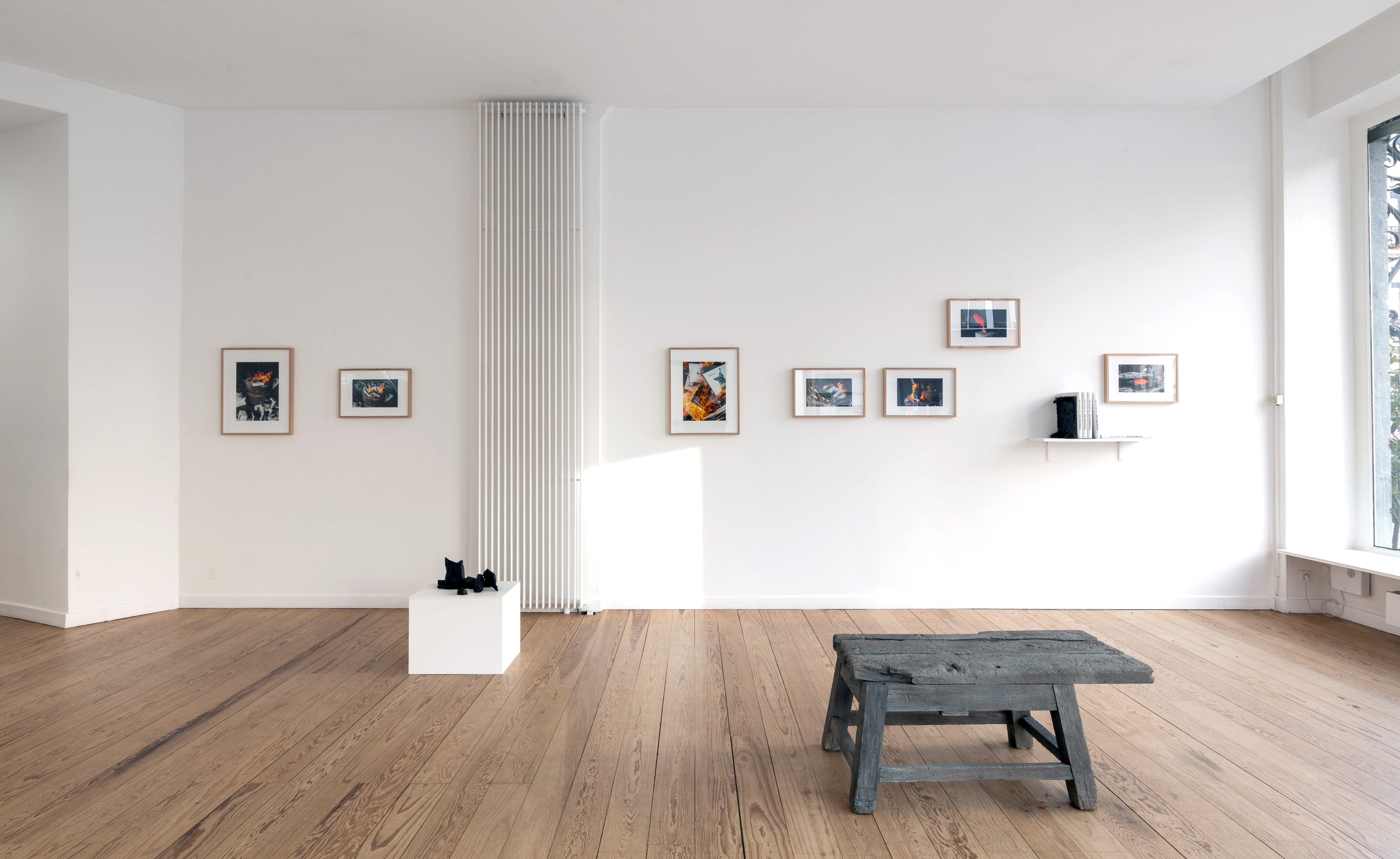Bronze, sweat and tears
Stefan Nikolaev
March 3rd - April 9th, 2016
Michel Rein, Brussels
Installation views




About
Fire is what results from a physical and chemical mechanism which shifts matter from a solid state to a gaseous state: as an event that was as spectacular as it was mysterious for the first human beings who undertook the task of mastering it, up until the pre-scientific period fire remained the source of countless speculation which gave rise to our modern chemistry.
It may have gradually disappeared from our day-to-day environment, in which it continues to exist solely through the incomparable attraction of its merry flames which still symbolize the heyday of cosy living rooms, but it rarely occupies centre stage, except to resurrect certain kinds of ancient fascination that we thought had gone forever...
When it is placed in the foreground of an artistic process, however, it re-finds all its dazzle and all the power of its former symbolism. Playing with fire is nothing less than dangerous, as we are all well aware, above all when this involves attacking another no less powerful symbol, the book. If book burning has aroused so many horrified reactions in the course of history, this is perhaps because what was at issue was a historical fight between reason and instinct, refinement and brutality: the destruction of books by fire is never a good sign, it plunges us back into the darkest moments of History, invariably attesting to a defeat of literature, poetry and art. That a living artist in this early 21st century should want to re-appropriate this symbolism in order to get it to re-enact a new chapter (Autofiction (process)) is indeed a sign that the spectacle of fire devouring the pages of a book is enough to plunge us back into ancient forms of abhorrence, echoes of primitive rituals always ready to surge forth again: when extremists want to get rid of the symbols of western society, they who live to the beat of “social networks”, it is by committing piles of “impure” books and magazines to the bonfire; when they want to ward off the power of the great Satan, it is again through fire, by burning American flags: an age-old reflex which illustrates an unchanged trust in the ancient deity, a paradoxical humanity which combines belief in the most primitive magic with the most developed technology of smartphones and satellites...
Needless to say, when Nikolaev proceeds with these “auto-autodafés”, what is involved is a tongue-in-cheek message, a thousand leagues from the message of those who hold free thought in contempt. The destruction of his own catalogues stems more from the liberating and celebratory act and from a questioning of the power of the book in the age of digital omnipotence. Burning a catalogue is, however, not altogether benign: there must certainly be a cost in terms of narcissism for sending up in smoke what represents the culmination of a complex artistic process and the symbol of an undeniable success; even if it is not a question of destroying the entirety of the stock, it is nevertheless a matter of admitting to yourself that this latter risked ended up in the dustbin of history... For all this, the artist’s gesture has nothing to do with any kind of feeling of bitterness; involved, on the contrary, is a re-injection of fuel inside a process which never stops, that of creation. The artist contrasts the creation of the lethal stabilization of a career which may be represented by the publication of a doorstop of a catalogue with the vitalist image of its fertilization and regeneration by way of fire. The book as fuel will serve to feed a hearth which will give birth to new pieces: nothing is lost in an artistic career, everything is re-created and everything is transformed Lavoisier’s theory of the conservation of matter is taken up here in an artistic version.
There is a similarity with the work of the great Scottish artist Simon Starling, who also seems to draw inspiration from the theories of the famous French chemist. The successive changes to which Starling subjects his various vehicles, boats, bicycles, and machines of every kind, which he transforms into one another by re-creating their geopolitical itinerary, find a less dramatic echo in Nikolaev’s work. But we find a sort of derision and craziness in these “mercantile exchanges” which is altogether foreign to the political ecology which informs the Scottish artist when, in his famous piece, Shedboatshed (Mobile Architecture No 2) produced in 2005, he used the wood of the boat on which he had embarked to feed the steam boiler propelling it. Nikolaev’s fuel may permit him to metaphorically saw off the branch on which he is sitting, yet it will not give rise to any edifying fable, but rather to the metamorphosis of an ancient play into a new one, and to the shift from one medium to another, from 2D to 3D, from comic strip to sculpture, and from paper to bronze: this half of Vil coyote, the notorious antihero of the famous comic, whose volume he breaks up to create an unlikely wedge of books (Autofiction), thus comes about from the combustion/retrieval of the famous catalogues and will obviously be used to array these same volumes on his bookshelves: theloop thus comes full circle, with the eulogy of metempsychosis which moves the artist’s mind from one form to another in a total disrespect of the high-tech/low-tech hierarchy being Nikolaev’s trademark.
For this artist, in the end of the day, it is more a matter of minimizing the scope of an artistic trajectory while at the same time reinvigorating the form of the vanitas: the title itself, Bronze, Sweat and Tears, which revisits Churchill’s famous words asking the English people to pull together in the war effort, is part of the ambient derision as well as of a diffused sense of the relativity of the power of art, not to mention the vanitas. We know that Nikolaev is often concerned with the idea of this latter which he has presented in many variants, in particular in those famous ceramic skull/ashtrays (What doesn’t kill you makes you stronger, 2009): vanitas squared, vanitas 2.0? Isn’t the production of “utilitarian” vanitases a way of making fun of them? Isn’t burning a catalogue, in a gesture that is as iconoclastic as it is scandalous, an attempt to rewrite its inexhaustible history? Except that over the idea of the “dry” vanitas, Nikolaev prefers that of the Phoenix being reborn from its ashes, a matter of extending a rich sequence rather than closing it. So just as the stock of sacrificed catalogues is part and parcel of the creation of new pieces, the embers which were used for another conflagration will act as a matrix for new bronzes-thoroughly original forms, to boot--, in a more than exaggerated endless duplication (mise en abyme) between the raw matter of the casting and the final form of the work (Hello Darkness); ditto for the burnt frames (Title to come shortly) which still fuel the same reflection. The most incongruous of these pieces, Business, model, sculpture, reverses this way of looking at the vanitas, to lend consistency and push into eternity what, on the face of it, seems to stem from the humblest humanity, the modest bench which the craftsman caster uses to sit his backside on...
Patrice Joly
February 2016

